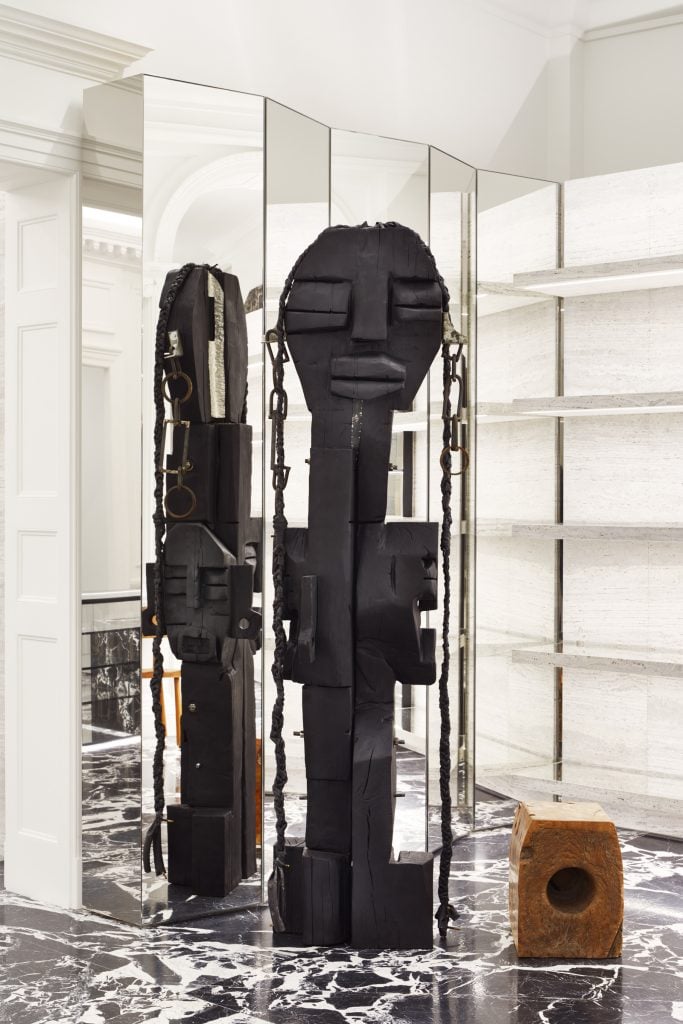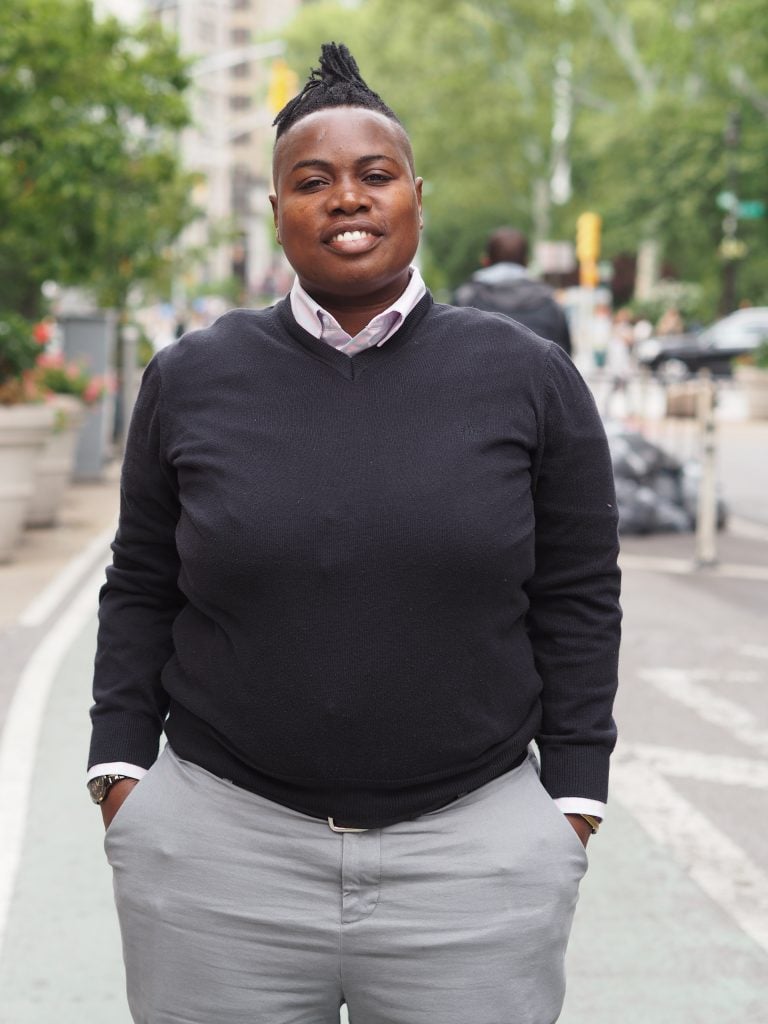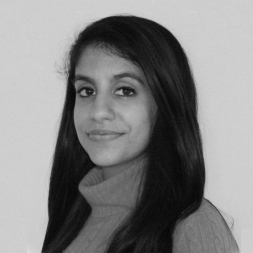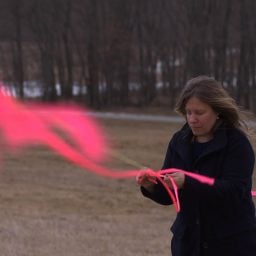Ugandan artist Leilah Babirye’s hand-carved wood and ceramic sculptures—many of them figures and faces inspired by African masks that seek to expore the diversity of LGBTQI identities—have captured the attention of the international art world ever since she participated in the Fire Island Art Residency in 2015, the same year she fled Uganda for New York City after being outed in the local newspaper.
In the spring of 2018, the artist was granted asylum with the help of the African Services Committee and the NYC Anti-Violence Project. Ever since then, she has diligently sought to refine her artistic practice in Brooklyn, crafting works that incorporate and assign value to discarded materials that recall the idea of ebisiyaga, in Luganda—which describes the husk of sugarcane, and is a derogatory term for a gay person.
“It’s rubbish,” the artist has said of the meaning of the word, in her gallery bio. “The part of the sugarcane you throw out.”
Babirye presented her first solo exhibition at Gordon Robichaux in New York in 2018 and earlier this year had her first London-based solo show with Stephen Friedman Gallery. In 2020, she had solo shows with both Rebecca Camacho Presents in San Francisco and Gordon Robichaux. Her work was also featured for Public Art Fund’s Art on the Grid project, and in a number of institutional shows, including at the Hessel Museum of Art at Bard College.
Recently, Babirye was tapped for Celine’s Art Project, an ongoing initiative begun by the French luxury brand’s creative director Hedi Slimane to exhibit the work of up-and-coming artists in Celine stores around the world. This month, the brand will unveil a new sculpture comissioned by Babirye in its New Bond Street flagship shop.
We recently spoke with Babirye about how she prepared for the project, how it turned out, and what it’s like to be an artist working today.

Leilah Babirye, “Najunga From the Kuchu Ngaali (Crested Crane) Cla” (2021). Photo courtesy Celine.
How did Celine approach you about the project?
They approached me through my gallery. I’m not sure if it was after the show that I had with Stephen Freidman, but they let me know that they wanted a sculpture for their [New Bond Street] store. So they commissioned it by asking me to do something similar to another piece, with a particular shape and size in mind, which I’d never done before. I never know what my next project is going to look like… I don’t even do sketches. The idea usually just comes straight from my head and goes into the piece. But this project also challenged me to figure out how to work if a collector wanted to commission something very specific, which was interesting to me.
Outside of the specifications, were you given any other direction?
It was mainly about the size. They wanted the same scale of the piece that they shared with us as a reference, which was nine-and-a-half feet tall by 26.5 feet by 20 inches. It’s a big piece… and I had to use the same piece of wood. It was maybe over 1,000 pounds. But as with all wood, if you keep on drying it, it gets lighter.
Wow. What did you want to say through the piece? Since you mentioned you don’t plan your works much in advance and they take shape as you go along, did the piece’s message change at all?
I was looking at the piece they gave us to reference, which was a totem that had three faces. The first face was really, really high and the other two faces were I think on the side. I wanted the piece to have a certain simplicity… it also engages a new material in metal, especially when you look at the ears. Those are new ears actually. They aren’t the wooden ears I usually make, and they’re going to be on several of my new sculptures. They’re inspired by when I’m rubbing my head and thinking of what to produce next, and how beautiful it is to be able to create. I suppose that’s something that changed along the way, a new development.
How long did it take you overall to create the piece from start to finish?
I was contacted in July… I do put a lot of time into my work. But I think I put more time into this particular piece, because even just figuring it out, like, “What do I want to do?” took me several weeks. Jacob [Robichaux] was like, “Do you have anything in mind?” and I told him, “This is not how I work. I have to just go to the studio and work and see.” It’s really the first time that I had to think so far in advance about the concept because I’ve never worked under…
… a deadline like this one?
A deadline, yes, but when someone wants something so particular. I had a hard time, and I did sketches, which I never do, but nothing really came out. But then finally, like two months later, we had some wood in the studio that was already stocked and dried, so we looked at it and sketched it and then polished it and burnished it and added elements and subtracted elements, and then it kind of came together, slowly.
I love the expression on the face. Can you tell me what you wanted the expression to convey?
I always leave that open for people to tell me how they feel about what the work communicates to them. I think it carries a lot. There’s this man who really loves my work and he says he looks at the eyes like gods that talk to him. I appreciate that interpretation, mainly because the eyes of my sculpture never open up; they’re closed. So there’s a lot to say about the face and the expression themselves, which I always leave to the viewers to figure out. I don’t want to speak for my work. I want people to feel like it’s speaking to them in their own way. It’s also interesting, because I try to keep my eyes open when I’m carving, but I end up closing them. In the end, I don’t really know what happens or how it gets done. I just find that all the eyes look like that.
You seem to suggest that working under deadlines is in some ways antithetical to the practice of an artist. The best case scenario is that you’re able to get up every day and go to your studio and create something that you feel is a step forward, or just something that feels true on that day. After having done this, what are your thoughts now on doing time-sensitive, site-specific commissions? And is there a difference knowing the piece will live in the context of a store versus in an art institution or a gallery?
I can’t say it really impacted the process all that much, to be honest. I used the same techniques, the same way that I’ve been working, though I did take some time to get into the rhythm maybe because of all these things… But it was basically about maintaining the simplicity of the idea, picking out certain things and putting others back. But I still came up with something they liked, which is good.
How are you feeling about working as an artist in 2021 more generally? I know you’re preparing for so many projects and exhibitions. But what does it feel like to make art these days, for you?
It is healing. It is the future. It is life, actually. Because, aside from finances, art also gave us something in the pandemic to hold on to. It makes you feel like there is another day tomorrow. It was weird waking up to empty streets every day and walking to my studio. That was very scary, but I also had something to come to every day, just in waking up and going to work. That in many ways kept me alive. It was also quite an exciting period of time in some way because I was, thank god, doing work productively and finding out about others’ work. I hope I answered that right, I don’t know.
You did, thank you. I also wanted to ask about what your practice consists of every day. Is there a schedule you try to adhere to?
I’ll always get to my studio at 10:30 or 11 a.m. And then I’ll have Zoom meetings to catch up for 30 minutes with my gallery every single day. We kind of touch base on everything. I’ll start working around 11. If I’m in the mood of painting, I’ll pull out the paints and just a play a little, sometimes with music in the background. I’m in there. Sometimes I’ll go in with my lunch. When I’m the mood of sculpture—I have two studios—and if I’m working toward something like a show, I’ll work on ceramics and sculpture. I’ll get there at 11 and we’ll work—I have two assistants—until about three and then they go home. I’ll go back to the other studio for another three hours. I’m home at 7. I like going to the gym for one hour. I realize if I don’t work out, I don’t have any energy. Then I’ll have some dinner and usually watch a movie from 9 until around 12.








